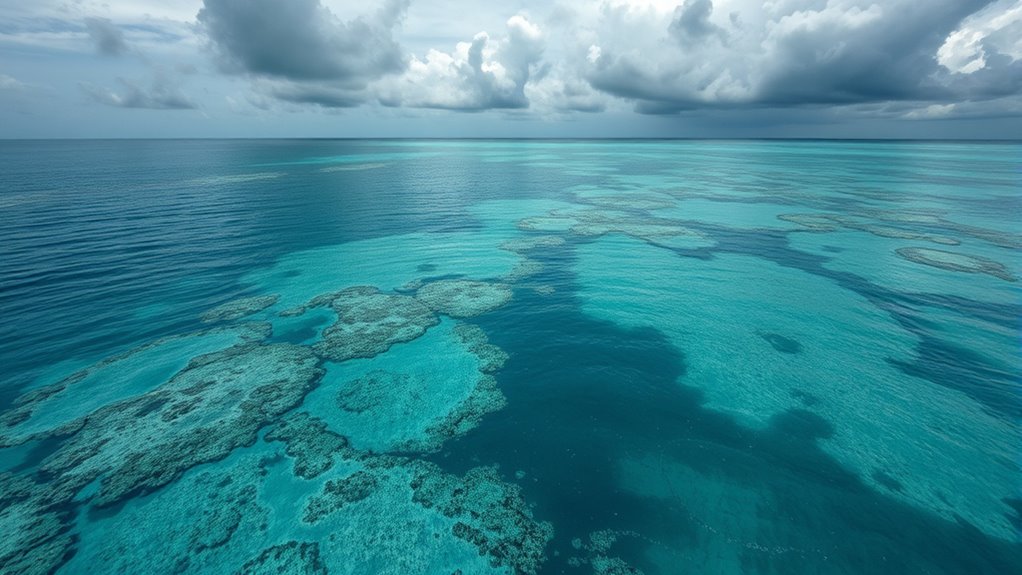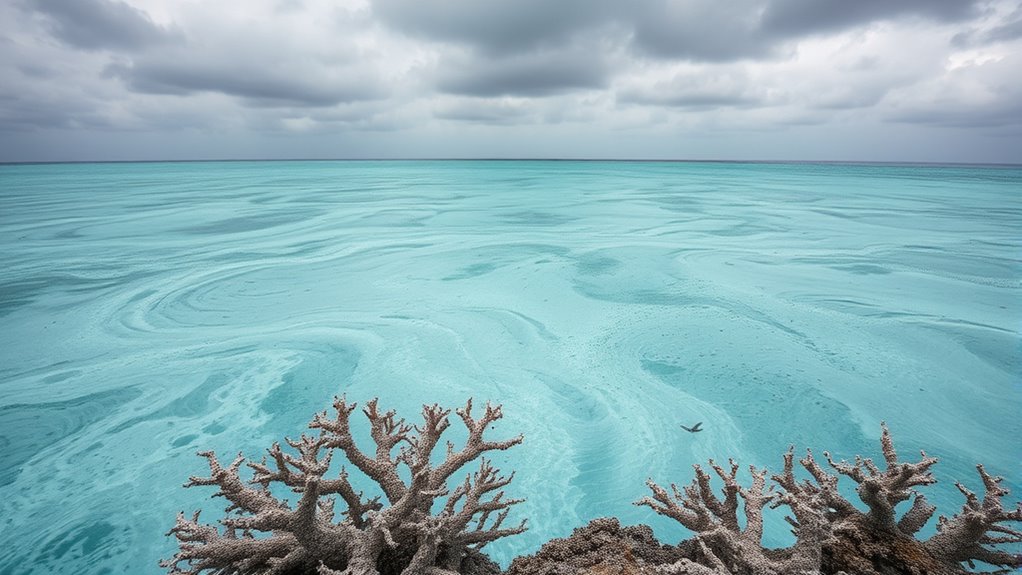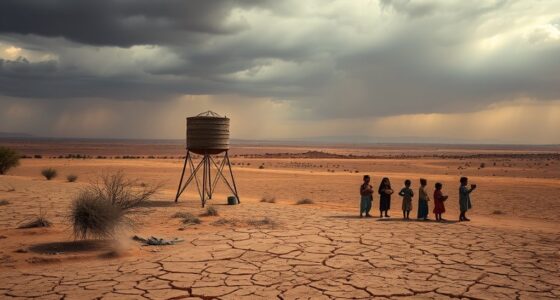Ocean acidification is now reaching dangerous levels due to increased carbon dioxide emissions from human activities like burning fossil fuels and deforestation. As your oceans absorb CO₂, their pH drops, making it harder for corals and shellfish to build calcium carbonate structures. This weakens reefs and harms marine biodiversity, affecting fishing and communities that depend on healthy oceans. If you want to understand how these changes impact ecosystems and what can be done, keep exploring.
Key Takeaways
- Increased CO₂ emissions from human activities cause ocean acidification, damaging marine life and ecosystems.
- Acidification hampers coral reef growth, leading to bleaching, habitat loss, and decline in biodiversity.
- Rising acidity weakens shell formation in mollusks and plankton, disrupting the marine food chain.
- Ocean deterioration reduces fish populations, impacting global seafood supplies and local fishing communities.
- Urgent conservation efforts and emission reductions are necessary to prevent irreversible ocean ecosystem damage.

Oceans face unprecedented threats from human activities that are accelerating their decline. One of the most visible signs of this crisis is coral bleaching, a process that occurs when corals become stressed by environmental changes, especially rising temperatures and acidification. When corals bleach, they lose their vibrant colors and become vulnerable to disease, often leading to widespread death. This not only devastates the delicate coral ecosystems but also endangers the rich marine biodiversity that depends on them. As corals die off, the complex habitats they provide are lost, impacting countless species that rely on these structures for shelter, breeding, and feeding. Without healthy coral reefs, entire marine communities are at risk of collapse, causing a ripple effect through the ocean’s food web.
Your role in this crisis is significant. Human activities like burning fossil fuels, deforestation, and industrial emissions release vast amounts of carbon dioxide into the atmosphere. Much of this CO₂ gets absorbed by the oceans, leading to acidification that threatens marine life at every level. Acidification makes it harder for shell-forming creatures, such as mollusks and some plankton species, to build their shells and skeletons, disrupting the base of the oceanic food chain. When these foundational species decline, it jeopardizes not just individual populations but the entire marine biodiversity. The loss of biodiversity weakens the resilience of ocean ecosystems, making them less able to recover from disturbances like storms or pollution.
You can’t ignore the fact that ocean acidification exacerbates existing problems like coral bleaching and species loss. When the water becomes more acidic, it hampers the ability of corals and other marine organisms to maintain their calcium carbonate structures, accelerating the degradation of reefs. The decline in coral reefs means fewer breeding grounds and nurseries for fish, which affects fishing communities and global seafood supplies. As these ecosystems deteriorate, you might notice a decline in fish populations, reduced biodiversity, and the loss of natural beauty that once thrived in vibrant, lively reefs. The combined impact of acidification and bleaching pushes marine ecosystems closer to tipping points, where recovery may become impossible.
It’s clear that human actions are directly fueling these destructive changes. Every emission of greenhouse gases contributes to acidification and coral stress, pushing oceans further toward collapse. But you also hold power to make a difference. Supporting policies to reduce carbon emissions, advocating for marine protected areas, and choosing sustainable seafood are steps you can take to help preserve marine biodiversity. By understanding how coral bleaching and acidification intertwine, you gain insight into the urgency of protecting our oceans before irreversible damage is done. The future of marine life and the health of our planet depend on what you do today.
Adding to this, recent studies show that high-precision monitoring of ocean chemistry can help identify early signs of ecosystem stress, enabling targeted conservation efforts.
Frequently Asked Questions
How Does Ocean Acidification Specifically Affect Coral Reef Ecosystems?
You’ll see that ocean acidification causes coral reef ecosystems to suffer markedly. It hampers corals’ ability to build their calcium carbonate skeletons, leading to weakened structures. This results in coral bleaching and increases reef degradation, which harms the diverse marine life depending on them. As a consequence, the entire ecosystem becomes vulnerable, threatening fish populations and coastal protection. Immediate action is essential to prevent irreversible damage to these critical habitats.
What Are the Primary Human Activities Contributing to Acidification?
You contribute to ocean acidification mainly through industrial pollution and deforestation effects. Industrial processes release carbon dioxide (CO2), which dissolves into oceans, increasing acidity. Deforestation reduces trees that absorb CO2, amplifying the problem. When you burn fossil fuels or cut down forests, you’re adding to the CO2 levels in the atmosphere, accelerating acidification and harming marine life. Small actions can make a big difference in reducing these impacts.
Can Ocean Acidification Be Reversed or Mitigated Effectively?
You can help mitigate ocean acidification by supporting geoengineering solutions that reduce CO2 in the atmosphere and advocating for marine buffer zones. These zones protect vulnerable ecosystems and promote natural recovery. While reversing acidification entirely is challenging, these measures can slow its progress and improve ocean health. Staying informed and encouraging policies that focus on emission reductions and conservation efforts make a real difference in safeguarding our oceans.
How Does Acidification Impact Fish Populations and Fisheries?
You might not realize it, but ocean acidification disrupts fish reproduction, threatening their populations. As acidity rises, fish struggle to reproduce effectively, leading to declines in stocks. This directly impacts fisheries, making management more challenging. If these trends continue, fish populations could plummet, leaving fisheries in jeopardy. Urgent action in fisheries management can help, but only if you understand the risks acidification poses to your future seafood supply.
Are Any Regions More Vulnerable to Ocean Acidification Than Others?
You should know that some regions, like coral reefs in the Indo-Pacific and the Arctic, are more vulnerable to ocean acidification. These regional hotspots face faster pH declines, threatening marine life and local fishing communities. Vulnerable communities relying on fisheries feel the impact quickly, risking their livelihoods. Acting now is essential to protect these areas and support the people who depend on healthy oceans for their survival.
Conclusion
You stand at the edge of a dying world, where the once vibrant ocean now bears scars of acid’s relentless assault. The shimmering blue fades to a ghostly pallor, and you can almost hear the silent cry of marine life struggling beneath the surface. If you don’t act now, this once majestic domain may become a barren, acidic wasteland, erasing its beauty and life forever. The choice is yours—protect what remains before it’s swallowed by despair.









